Jan's Computer Basics:
Storage: Magnetic Disks
Of the various types of Auxiliary Storage, the types used most often involve some type of magnetic disk. These come in various sizes and materials, as we shall see. This method uses magnetism to store the data on a magnetic surface.
| Advantages: |
|
A drive spins the disk very quickly underneath a read/write head, which does what its name says. It reads data from a disk and writes data to a disk. (A name that actually makes sense!)
Types of Magnetic Disks
Hard Disks
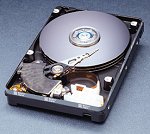
Credit: Western Digital
A hard disk consists of 1 or more metal platters which are sealed inside a case. The
metal is one which is magnetic. The hard disk is usually installed inside
the computer's case, though there are removable and cartridge types, also.
Technically the hard drive is what controls
the motion of the hard disks which contain the data. But most people use
"hard disk" and "hard drive" interchangeably. They don't make that mistake
for floppy disks and floppy drives, described below. It is clearer with floppies that the
drive and the disk are separate things.
Diskette / Floppy Disk (extinct?)
Both sizes are seem to be extinct in work places. The only remaining flocks of such disks are hiding among the dust balls in back storage closets, waiting for someone to decide what to do with them.
Sizes:
| 5¼" (really ancient stuff)  |
3½" (just horribly old) 
|
Both sizes are made of mylar with an oxide coating. The oxide provides the magnetic quality for the disk. The "floppy" part is what is inside the diskette covers - a very floppy piece of plastic (i.e. the mylar).
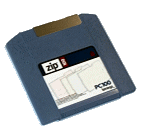 Other Removable Magnetic Media
Other Removable Magnetic Media
Several other kinds of removable magnetic media are in use, such as the Zip disk. All of these have a much higher capacity than floppy disks.
Each type of media requires its own drive. The drives and disks are much more expensive than floppy drives and disks, but then, you are getting much larger capacities.
There are other kinds of storage devices that are not magnetic, such as flash drives and optical discs (CD and DVD) or that are not disks, such as magnetic tape. These will be discussed later.
Care of Hard Disks
To keep your hard disk happy and healthy you must observe a few precautions. Each medium has its own particular weaknesses and hazards to avoid. Be careful or suffer the consequences - lost data, which means, at best, lots of lost time and effort!
Don't |
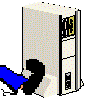 Jar the computer while the disk is spinning. |
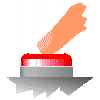 Turn the computer off and quickly back on before spinning has stopped. |
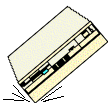 Drop it - ever. |
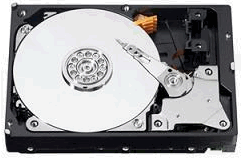
Credit: Western Digital
Hard disks are protected by being sealed in air-tight cases. But when damage does occur, it is a more serious matter that with removable media. Larger amounts of data can be lost and hard disks are much, much more expensive that removable disks.
Hard disks can have problems from magnetic fields and heat, but these are rare.
Most problems occur when the read/write head (looks like a pointer in the photo) damages the metal disk by hitting or even just touching it. This is called a head crash.
 When the computer is on, the hard disk is spinning extremely fast. Any contact at all can cause pits or scratches. Every scratch or pit is lost data. Damage in the root directory turns the whole hard disk into a lovely doorstop! It's completely dead.
When the computer is on, the hard disk is spinning extremely fast. Any contact at all can cause pits or scratches. Every scratch or pit is lost data. Damage in the root directory turns the whole hard disk into a lovely doorstop! It's completely dead.
So the goal here is to keep that read/write head where it belongs, just barely above the hard disk, but never, ever touching it.
